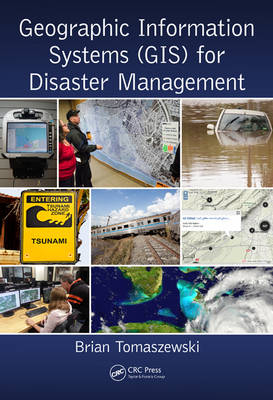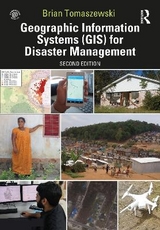
Geographic Information Systems (GIS) for Disaster Management
Apple Academic Press Inc. (Verlag)
978-1-4822-1168-9 (ISBN)
- Titel erscheint in neuer Auflage
- Artikel merken
Brian Tomaszewski PhD is a geographic information scientist with research interests in the domains of geographic information science and technology, geographic visualization, spatial thinking, and disaster management. His published research on geographic information systems (GIS) and disaster management related topics has appeared in top scientific journals and conferences such as Information Visualization, Computers, Environment and Urban Systems, Computers and Geosciences, the IEEE Conference on Visual Analytics Science and Technology, and The Cartographic Journal. He also regularly publishes in popular GIS trade magazines such as ArcUser and ArcNews. He also is also as a scientific committee member for the Information Systems for Crisis Response and Management (ISCRAM) conference. Dr. Tomaszewski's relevant experience includes past work with internationally focused organizations interested in GIS and disaster management such as the United Nations Office for the Coordination for Humanitarian Affairs (UN-OCHA) ReliefWeb service, United Nations Office for Outer Space Affairs Platform for Space-Based Information for Disaster Management and Emergency Response (UN-SPIDER), and United Nations Global Pulse. He also served as a visiting research scientist with the United Nations Institute for Environment and Human Security (UNU-EHS) in Bonn, Germany. He mentored and instructed multidisciplinary GIS for disaster management student research groups via the National Science Foundation (NSF)-funded Science Master’s Program (SMP) titled Decision Support Technologies for Environmental Forecasting and Disaster Response at the Rochester Institute of Technology (RIT). His research on geospatial technology educational development and spatial thinking in Rwanda has been supported by the United Kingdom Department for International Development (UK-DFID) and he is actively involved in other funded computing research activities in Rwanda. Brian is currently an assistant professor in the Department of Information Sciences and Technologies at the Rochester Institute of Technology. He holds a PhD in geography from the Pennsylvania State University. For more information, visit: http://people.rit.edu/bmtski/.
A Survey of GIS for Disaster Management
Chapter Objectives
Introduction
GIS and Geographical Context
GIS and Situation Awareness
The Problem: Continued Need for GIS in Disaster Management
Scale, Scope, and Intensity of Disasters
Case Study: Burkina Faso—Disasters in the Developing World
The Need for Improved Coordination, Sharing, and Interoperability
Problems of GIS Awareness in Disaster Management
The Opportunity: Increased Awareness and Advocacy of GIS and Mapping
Crisis Mapping
Interview with Dr. Jen Ziemke, Cofounder and Codirector of the International Network of Crisis Mappers
Spatial Thinking and Disaster Management
Chapter Summary
Discussion Questions
References
Fundamentals of Geographic Information and Maps
Chapter Objectives
Introduction
Data vs. Information
Scale
Three Ways of Representing Map Scale
Large- vs. Small-Scale Maps
Why Scale Matters: Detail and Accuracy
Map Projections
Coordinate Systems
Universal Transverse Mercator Coordinate System
State Plane Coordinate (SPC) System
Datums
Reference Ellipsoids
Control Points
The Importance of Datums
Coordinate Systems: The Whole Picture
Basic Principles of Cartography
Mapping Principles
Data Measurement
Visual Variables
Figure and Ground Relationships
Map Types: Reference and Thematic
Reference Maps
Thematic Maps
Summary
Designing Usable Maps in a GIS Context
Common Examples of Poorly Made Maps Created with a GIS
Interview with Dr. Anthony C. Robinson
Chapter Summary
Discussion Questions
Resources
Principles of Mapping
Geodesy (including datums and reference ellipsoids)
History of Cartography
Basics of Statistical Data Classification for Maps
Designing Good Maps in a GIS Context
Map Color
References
Geographic Information Systems
Chapter Objectives
Introduction
What Is GIS?
Organizing the World Geographically: Map Layers
What Can You Do (and Not Do) with GIS Software?
Data and Spatial Asset Management
Analysis
GIS Programming
Modeling
Cartography, Visualization, and Map Production
Geocoding
Limitations of GIS
Understanding GIS Data Models
Vector Models
Raster
GIS Metadata
Specific GIS Technology
GIS Technology Platforms and Disaster Management
ArcGIS
Google Maps and Other Google Geospatial Technology
QGIS
Other Commercial, Free, and Open-Source or Openly Available GIS Technologies
OpenStreetMap
Other GIS Technologies
Free and Open-Source Datasets Relevant to Disaster Management
How to Choose the Right GIS Technology for Disaster Management
Getting Started with GIS Technology and GIS Technology Configuration Ideas
Chapter Summary
Discussion Questions
Resources
References
Disaster Management and Geographic Information Systems
Chapter Objectives
Introduction
Disaster Management Cycle
Terms: Emergency, Disaster, Crisis, and Catastrophe
Disaster Management Cycle
Role of GIS within Disaster Management Policy and Practice
Policy in the United States: The National Incident Management System (NIMS)
Incident Command System (ICS)
United States Department of Homeland Security (DHS) Geospatial Concept of Operations (GeoCONO PS)
United States National Spatial Data Infrastructure
Local Government: Cities, Towns, and Counties
County GIS: Interview with Mr. Scott McCarty
State
National
FEMA
GIS and Other US Federal Agencies
Non-US Federal-Level Disaster Management: Interview with Dr. Michael Judex
Private Sector
Private Sector Perspective: Interview with Alan Leidner
International Disaster Management Community and GIS
Nongovernmental Organizations
MapAction
Humanitarian OpenStreetMap Team (HOT )
Crisis Mappers
GISCorps
International Disaster Management Support Mechanisms
International Charter on Space and Major Disasters
Global Disaster Alert and Coordination System (GDACS)
World Bank GFDRR
United Nations
Office for the Coordination of Humanitarian Affairs: ReliefWeb
UN-SPIDER
UN-SPIDER Perspectives: Interview with Antje Hecheltjen
GIS, Disaster Management, and the United Nations: Interview with Dr. Jörg Szarzynski
Chapter Summary
Discussion Questions and Activities
Resources
References
Geographic Information Systems and Disaster Planning and Preparedness
Chapter Objectives
Introduction
Technology and Dataset Planning and Preparation
Essential Disaster Management Map Layers
Additional Sources of Ideas for Essential Disaster Management Map Layers
Department of Homeland Security Geospatial Data Model
Technology Planning and Preparation
Organizational Perspectives
Using GIS to Support Planning and Preparation Activities
Spatial Perspectives on Broader Planning and Preparation Activities
Common GIS Tasks for Disaster Planning and Preparation Activities
Evacuation Route Planning
Evacuation Zone Planning
Scenario Modeling to Answer What-If Questions
Public Outreach and Citizen Participation
GIS and Disaster Management Planning: A United Nations Perspective
Interview with Lóránt Czárán
Summary
Discussion Questions and Activities
Resources
References
Geographic Information Systems and Disaster Response
Chapter Objectives
Introduction
Disaster Response Policy in the United States
Geographical Aspects of Situation Awareness
Maps and Emergency Operation Centers
GIS and Disaster Warnings
Spatial Data Deluge
Hot Spot Mapping
Density Mapping
Real-Time GIS
Disaster Response GIS Products
Online Disaster Response Geographic Data Streams
GIS and Damage Assessment
Field Data Collection and Mobile GIS
Public and Disaster Response Mapping: Crisis Mapping and Citizen Reporting
Chapter Summary
Discussion Questions and Activities
Resources
References
Geographic Information Systems and Disaster Recovery
Chapter Objectives
Introduction
Geographical Aspects of Disaster Recovery
Using GIS to Support Disaster Recovery Tasks
Geocollaboration
Restoring Critical Infrastructure
Debris Cleanup
Recovery Planning
Transition from Recovery to Mitigation
Interview with David Alexander: US Federal Government Geospatial Technology Leader
and Expert
Chapter Summary
Discussion Questions and Activities
Resources
References
Geographic Information Systems and Disaster Mitigation
Chapter Objectives
Introduction
Vulnerability
Resilience
Disaster Mitigation Policy and International Perspectives on GIS
The United States National Mitigation Framework
International Perspectives on Disaster Mitigation: UNISDR
GIS Techniques for Disaster Mitigation
Spatial Indexing and Modeling of Risk and Vulnerability
Social Variables
Physical Variables
Using GIS to Develop Spatial Indexes of Vulnerability and Risk
Chapter Summary
Discussion Questions and Activities
Resources
References
Special Topics
Chapter Objectives
Introduction
Special Topics
Visual Analytics
Big Data and Disaster Management
Serious Games for GIS and Disaster Management
Geographic Information Science and Disaster Management
The Future of GIS for Disaster Management
Interviews
Jen Zimeke, PhD, Crisis Mappers (Chapter 1, Specialty: Crisis Mapping)
Anthony Robinson, PhD, Penn State (Chapter 2, Specialty: Cartography)
Alan Leidner, Booz Allen Hamilton (Chapter 4, Specialty: XXX)
Antje Hecheltjen, UN-SPIDER (Chapter 4, Specialty: XXX)
Michael Judex, PhD, German Federal Office of Civil Protection and Disaster
Assistance (Chapter 4, Specialty: XXX)
Scott McCarty, Monroe County GIS (Chapter 4, Specialty: XXX)
Lóránt Czárán, United Nations Cartographic Section and Office for Outer Space
Affairs (Chapter 5, Specialty: XXX)
David Alexander, US Federal Government (Chapter 7, Specialty: XXX)
Research Agenda
Developing a GIS for Disaster Management Career
Interviews
Alan Leidner (Chapter 4)
Antje Hecheltjen (Chapter 4)
Michael Judex, PhD (Chapter 4)
Scott McCarty (Chapter 4)
Jörg Szarzynski, PhD (Chapter 4)
Lóránt Czárán (Chapter 5)
David Alexander (Chapter 7)
GIS for Disaster Management Career Summary Points
Staying Current in the GIS for Disaster Management Field
Organizations
Conferences
Journals and Magazines
Training and Education
Volunteer Opportunities
Chapter Summary
Discussion Questions and Activities
Resources
References
| Zusatzinfo | scatter color - see page breakdown for page numbers; 1 Tables, black and white; 148 Illustrations, black and white |
|---|---|
| Verlagsort | Oakville |
| Sprache | englisch |
| Maße | 178 x 254 mm |
| Gewicht | 748 g |
| Themenwelt | Naturwissenschaften ► Geowissenschaften ► Geografie / Kartografie |
| Sozialwissenschaften ► Pädagogik ► Sozialpädagogik | |
| Sozialwissenschaften ► Soziologie | |
| ISBN-10 | 1-4822-1168-8 / 1482211688 |
| ISBN-13 | 978-1-4822-1168-9 / 9781482211689 |
| Zustand | Neuware |
| Informationen gemäß Produktsicherheitsverordnung (GPSR) | |
| Haben Sie eine Frage zum Produkt? |
aus dem Bereich



